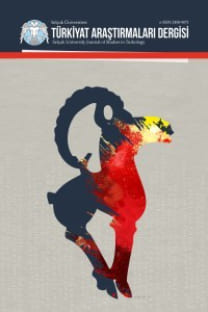THE SERPENT’S FANGS EMBEDDED IN THE HEEL: THE DIALOGIZATION OF AUTHORITY IN NAMIK KEMAL’S INTIBAH
The Turkish novelist Namık Kemal’s Intibah indicates how a character struggles against misrepresentation. In the novel, Ali Bey, a 22-year old educated boy, meets a very beautiful woman, whose name is Mehpeykey, as he walks in Çamlıca, and he falls in love with her. The narrator says that Mehpeyker does not have a virtuous background and he does his utmost to make the addressee hate her and believe that she is not a suitable partner for Ali Bey. However, the reader interestingly sympathizes with her throughout the novel because with her speech and actions Mehpeyker represents herself differently from what the narrator says about her. The present article studies the relationship and struggle between the narrator’s and Mehpeyker’s discourses based on the theory of the Russian critic Mikhail Bakhtin. Since in Intibah the narrator’s discourse appears as patriarchal discourse and another’s word as femininity which struggles against misrepresentation by patriarchy, a feminist reading of Bakhtin is also employed in the analysis of the novel. In Intibah Mehpeyker represents the voice of the other that disseminates the male authority of the narrator.
Keywords:
feminine other, , narrator, , dialogization, subversion of authority Mehpeyker,
___
- Akyol, S. (2006). Intibah’a dair. In Intibah. Ankara: Ozgur Yayinlari.
- Bakhtin, M. (1981). Dialogic imagination. Michael Holquist (Ed.). Austin: University of Texas Press.
- Bakhtin, M. (1984). Problems of Dostoyevsky’s poetics. Minneapolis: University of Minnesota Press.
- Banfield, A. (2000). From unspeakable sentences: narration and representation in the language of fiction.” Michael McKeon (Ed.), Theory of the novel (515-536). Baltimore & London: The Johns Hopkins UP. .
- Bauer, D. (1988). Gender in Bakhtin’s carnival. Robyn R. Warhol & Diane Price Herndl (Ed.), Feminisms: an anthology of literary theory and criticism (671-684). New Brunswick-New Jersey: Rutgers University Press.
- Cassirer, E. (1953). The philosophy of symbolic forms: language. R. Manheim (Trans.). New Heaven: Yale University Press.
- Cohn, D. (2000). Transparent minds: narrative modes for presenting consciousness in fiction. M. McKeon (Ed.), Theory of the novel (493-514). Baltimore & London: The Johns Hopkins UP.
- Hernall, D. P. (1991). The dilemmas of a feminine dialogic. Dale Bauer & S. Jaret McKinstry (Ed.), Feminism, Bakhtin, and the dialogic (7-24). Albany: State University of New York Press. 7-24.
- Enginün, İ. (2006). Yeni Türk edebiyatı/ Tanzimat’tan Cumhuriyet’e. Istanbul: Dergah Yayınları.
- Foucault, M. (1995). Discipline & punish. New York: Vintage Books.
- Gilbert, S. & Gubar, S. (1979). The madwoman in the attic. New Haven: Yale University Press.
- Kaplan, M. (1997). Türk edebiyatı üzerinde araştırmalar. Istanbul: Dergah Yayınları.
- Kemal, N. (2006). Intibah. Ankara: Ozgur Yayinlari.
- Moi, T. (1985). Sexual/textual politics. New York: Methuen
- Moran, B. (1983). Turk romanına eleştirel bir bakış I. İstanbul: Iletisim Yayincilik.
- Tanpınar, A. H. (2001). 19cu asır Türk edebiyatı tarihi. Istanbul: Çağlayan Kitabevi.
- Uçman, A. (2006). Namık Kemal. Prof. Dr. Ismail Parlatır (Ed.), Tanzimat edebiyatı (201-288). Ankara: Akçağ Yayınları.
- Voloshinov, V. N. (1973). Marxism and the philosophy of language. L. Matejka & I. R. Titunik (Trans.). Cambridge: Harvard University Press.
- ISSN: 1300-5766
- Yayın Aralığı: Yılda 3 Sayı
- Başlangıç: 1994
- Yayıncı: Selçuk Üniversitesi
Sayıdaki Diğer Makaleler
AYDIN VİLAYETİNDE AŞİRETLERİN İSKÂNI VE SORUNLAR (19. YÜZYILIN İKİNCİ YARISI)
DEMOKRAT PARTİ DÖNEMİ KONYA MİLLETVEKİLLERİ VE TBMM’DE KONYA İLE İLGİLİ FAALİYETLERİ
GÖYNÜKLÜ AHMED EFENDİ'NİN MECMUASI
YAZININ DOĞAL GELİŞİMİNE BİLGİ KURAMI TEMELİNDE FARKLI BİR BAKIŞ (TÜRKÇE ÖRNEĞİNDE)
BATI OĞUZ TÜRKÇESİNDEKİ YARDIMCI /Y/ SESİNİN KÖKENİ ÜZERİNE
İKTİDAR DEĞİŞİMİNİN DERS PROGRAMLARINA VE TARİH EĞİTİMİNE YANSIMASI (MEKTEB-İ SULTANİ ÖRNEĞİ)
